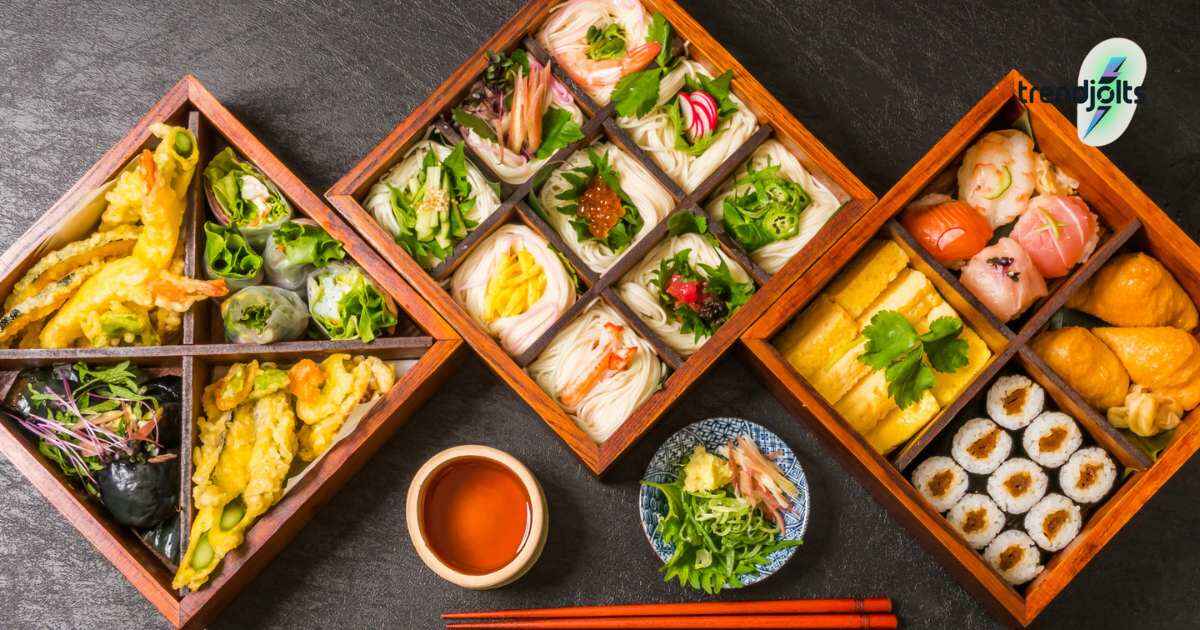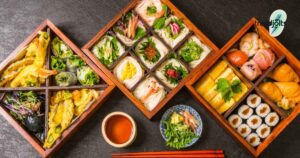you’re sitting in an authentic Japanese restaurant, confidently ordering ramen and sushi while impressing everyone around you with perfect pronunciation. No more awkward pointing at menu pictures or missing out on incredible traditional Japanese dishes because you can’t decode the names. Learning Japanese food vocabulary isn’t just about words – it’s your gateway to experiencing Japanese cuisine culture like a true insider.
Japanese food represents one of the world’s most fascinating culinary traditions, where every dish tells a story steeped in centuries of heritage. From mastering essential Japanese food words to understanding dining etiquette and exploring famous dishes like okonomiyaki and onigiri, this comprehensive guide transforms you from confused tourist to confident food enthusiast.
Whether you’re planning to visit Japan, cooking authentic dishes at home, or simply want to appreciate washoku (Japan’s UNESCO-recognized food culture) more deeply, you’ll discover everything needed to navigate Japan’s incredible culinary landscape like a pro!.
Why Learn Japanese Food Vocabulary?
Learning Japanese food vocabulary can turn a confusing dining experience into a confident one. Instead of guessing at menu items, you’ll know exactly what you’re ordering. These words aren’t just translations, they’re full of history and tradition that connect you to Japanese culture.
Japan’s traditional food culture, washoku, is even recognized by UNESCO as part of the world’s cultural heritage. It reflects the country’s values of harmony, seasonality, and respect for ingredients.
By understanding these terms, you’re doing more than ordering food; you’re embracing a way of life. Whether you’re visiting Japan, cooking at home, or just want to enjoy Japanese meals more deeply, this vocabulary makes the experience richer and more meaningful.
Japanese Food Vocabulary: Essential Words to Know
Building your Japanese food vocabulary foundation starts with everyday ingredients you’ll encounter everywhere. These fundamental terms help you shop at Japanese markets, understand recipe instructions, and communicate dietary preferences effectively. Don’t worry about perfect pronunciation initially – focus on recognizing these words when you see them written.
Each category below represents core building blocks of Japanese cooking ingredients. From fresh produce to pantry staples, these words appear constantly in Japanese food preparation contexts. Master these basics and you’ll find yourself confidently navigating Japanese culinary traditions with genuine understanding rather than guesswork.
Recommended Blog: Cultural Nuances to Understand When Learning Japanese
1. Fruits & Vegetables (果物 & 野菜 – Kudamono & Yasai)
Fresh produce forms the backbone of Japanese cuisine culture, with seasonal ingredients driving menu changes throughout the year. These essential fruits and vegetables appear in everything from traditional Japanese dishes to modern fusion creations:
- 🍏 Apple – りんご (ringo)
- 🍌 Banana – バナナ (banana)
- 🍓 Strawberry – 苺 (ichigo)
- 🍑 Peach – もも (momo)
- 🥒 Cucumber – キュウリ (kyuuri)
- 🥔 Potato – じゃがいも (jagaimo)
- 🥕 Carrot – ニンジン (ninjin)
2. Rice, Bread, & Grains (ご飯 & 穀物 – Gohan & Kokumotsu)

Rice dominates Japanese meals so completely that understanding grain terminology becomes crucial for any Japanese food journey. These staples form the foundation of Japanese cooking across all regions:
- 🍚 Rice (cooked) – ご飯 (gohan)
- 🌾 Rice (uncooked) – 米 (kome)
- 🍞 Bread – パン (pan)
- 🥜 Nuts – 木の実 (konomi)
- 🌰 Sesame seeds – 胡麻 (goma)
3. Meat & Seafood (肉 & 魚 – Niku & Sakana)
Japanese cuisine celebrates both land and sea proteins with equal reverence, creating dishes that highlight natural flavors. These protein terms appear constantly in Japanese restaurant menus and Japanese cooking recipes:
- 🐮 Beef – 牛肉 (gyuuniku)
- 🐔 Chicken – 鶏肉 (toriniku)
- 🐷 Pork – 豚肉 (butaniku)
- 🐟 Fish – 魚 (sakana)
- 🍤 Shrimp – 海老 (ebi)
- 🍣 Tuna – 鮪 (maguro)
4. Drinks (飲み物 – Nomimono)
Japanese drinking culture blends ancient traditions with modern preferences, creating diverse beverage options for every occasion. These drink terms help you navigate everything from casual cafes to formal dining experiences:
- ☕ Coffee – コーヒー (ko-hi-)
- 🍵 Tea – 茶 (cha)
- 🍶 Sake – お酒 (osake)
- 🥤 Beer – ビール (bi-ru)
Famous Japanese Dishes You Must Try
Japanese cuisine offers an incredible spectrum of flavors and textures that’ll blow your taste buds away. From delicate sushi rolls to hearty ramen bowls, each dish tells a story rooted in centuries of culinary traditions. You don’t need to travel to Japan to experience these masterpieces – many Japanese restaurants worldwide serve authentic versions that capture the essence of traditional Japanese dishes.
These iconic dishes represent different regions, cooking techniques, and cultural influences that shaped modern Japanese food culture. Whether you’re craving something light and fresh or rich and comforting, this collection covers every mood and occasion. Each dish showcases unique Japanese cooking ingredients and preparation methods that make washoku so special and UNESCO-worthy.
Also Read This Blog: Proven Tips for Memorizing Japanese Kanji Characters Effectively
🍛 Curry Rice (カレーライス – Kare Raisu)
Japan’s take on curry rice delivers thick, savory comfort that’s completely different from Indian or Thai versions. This beloved dish combines beef, potatoes, carrots, and onions simmered slowly in a rich curry sauce that’s mildly sweet and incredibly satisfying.
You’ll find it served over steaming rice in homes, school cafeterias, and restaurants across Japan. The curry roux creates a velvety texture that coats every grain perfectly, making each bite pure comfort food magic.
🥢 Okonomiyaki (お好み焼き – Japanese Pancake)
This savory Japanese pancake transforms simple ingredients into culinary gold through skillful preparation. Made with flour, eggs, and shredded cabbage, okonomiyaki gets topped with various proteins like seafood or pork before hitting the griddle.
The magic happens with the toppings – creamy mayonnaise, tangy okonomiyaki sauce, and dancing bonito flakes that move from the heat. Different regions create their own styles, with Osaka and Hiroshima versions sparking friendly debates among locals about which tastes better.
🍜 Ramen (ラーメン)
Ramen represents pure regional diversity in a single bowl, with each area of Japan creating distinctive styles. The foundation starts with wheat noodles swimming in flavorful broth – whether soy sauce, miso, salt, or rich tonkotsu pork bone broth.
Classic toppings include sliced pork, soft-boiled eggs, and green onions, but creative chefs constantly innovate with seasonal ingredients. Don’t hesitate to slurp loudly – it’s actually encouraged as a sign you’re enjoying this soul-warming traditional Japanese dish.
🍣 Sushi (寿司)
Sushi has conquered the world, but authentic versions showcase the artistry of vinegared rice paired with pristine fish, seafood, or vegetables.
You’ll encounter various styles including nigiri (hand-pressed rice topped with fish), maki (rolled varieties), and sashimi (just the fish, no rice).
The best sushi relies on impeccable ingredient quality and precise knife skills that take decades to master. Each piece should be eaten immediately after preparation to experience the perfect temperature contrast between cool fish and warm rice.
🍙 Onigiri (おにぎり – Rice Balls)
These portable rice balls serve as Japan’s ultimate convenience food, wrapped in seaweed and filled with delicious surprises. Popular fillings include tuna, salmon, pickled plum, or other savory ingredients that complement the seasoned rice.
Onigiri appears everywhere from convenience stores to home lunch boxes, providing satisfying nutrition that travels well. The art lies in achieving the perfect rice texture – firm enough to hold together but tender enough to bite easily.
🥢 Shabu Shabu (しゃぶしゃぶ – Japanese Hotpot)
This interactive Japanese hotpot experience brings people together around bubbling broth for DIY dining fun. Thinly sliced meat and fresh vegetables get swished quickly through the hot broth – the name comes from the swishing sound.
After cooking, you dip everything in ponzu or sesame sauce for extra flavor layers. Shabu shabu emphasizes ingredient quality over complex preparation, letting natural flavors shine through gentle cooking methods.
Japanese Food Etiquette: How to Dine Like a Local
Mastering Japanese dining customs shows respect for the culture and enhances your entire Japanese food experience. These etiquette rules aren’t just formalities – they reflect deep cultural values about gratitude, respect, and mindful eating. You’ll feel more confident and connected when you understand why these customs matter so much in Japanese food culture.
Following proper dining etiquette demonstrates cultural awareness that Japanese people genuinely appreciate. Whether you’re dining at a high-end Japanese restaurant or a casual ramen shop, these customs apply universally. Don’t stress about perfection – making an effort shows good intentions, and most people will appreciate your cultural sensitivity even if you make small mistakes along the way.
Don’t Miss Out This Blog: Learn Japanese ONLINE Through Anime and Manga
Vegetarian and Vegan Japanese Food Options
Japanese cuisine offers more plant-based treasures than most people realize, though traditional dishes often incorporate fish or meat elements. You’ll discover amazing vegetarian options that showcase vegetables, grains, and plant proteins in creative ways.
Many traditional Japanese dishes naturally avoid meat, focusing instead on seasonal produce and fermented ingredients that create complex umami flavors.
Modern Japan increasingly embraces vegetarian and vegan dining, especially in major cities where international influences shape restaurant menus. Here are some delicious plant-based options to explore:
- 🍠 Yakiimo (焼き芋) – Grilled sweet potato
- 🍡 Dango (団子) – Sweet rice dumplings
- 🥢 Vegetable tempura – Deep-fried battered vegetables
- 🍙 Umeboshi onigiri (梅干しおにぎり) – Rice balls with pickled plum
- 🍜 Miso soup (味噌汁) – Traditional fermented soybean soup
Useful phrases:
- “I don’t eat meat.” – 肉が食べられません (Niku ga taberaremasen)
- “I’m vegetarian.” – ベジタリアンです (Bejitarian desu)
- “Without meat, please.” – 肉なしでお願いします (Niku nashi de onegai shimasu)
Conclusion: Start Your Japanese Food Journey Today!
You’ve now unlocked the essential Japanese food vocabulary and cultural insights needed to confidently explore Japan’s incredible culinary landscape. Whether you’re dining at a Japanese restaurant, cooking authentic dishes at home, or planning your dream trip to Japan, this knowledge transforms every Japanese food experience into something truly meaningful and enjoyable.
Ready to dive deeper into Japanese cuisine culture? Start practicing these Japanese food words today, try cooking one of these traditional Japanese dishes at home, or visit your local Japanese restaurant armed with newfound confidence. Your Japanese food journey begins now – and trust us, once you start exploring washoku, you’ll discover flavors and experiences that’ll keep you coming back for more delicious adventures!










